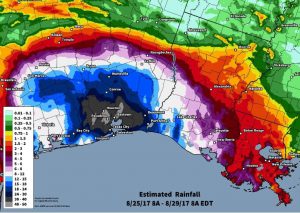I’m pleased to present a guest blog post from former NWS hydrologist John Feldt of Blue Water Outlook, discussing the impact of Hurricane Harvey on agriculture across the US. Tomorrow I will look at news reports on impacts of Harvey’s rainfall on agriculture across Texas.
Past Rainfall Totals
To date, rainfall associated with Harvey has primarily impacted livestock and hay-growing regions of Southeast Texas. An estimated 1.2 million head of cattle are within the core of heaviest rain.

Hurricane Harvey will start to lift northeast and accelerate later this week spreading heavy rain further inland. Note the large path cone by the weekend indicating a significant degree of uncertainty.
Tropical Storm Harvey Moves Further Inland
Heaviest rain, in some cased above 8 inches, can be expected over Southeast Texas, Louisiana, Arkansas, Mississippi, and parts of Tennessee, Kentucky, Alabama, Georgia, and Northwest Florida.
Total Rainfall Forecast
Impact on Livestock
Harvey’s future track will remain outside of the primary Great Plains livestock region but it could result in heavy rain over scattered livestock regions over the South Central U.S. and the Tennessee and Ohio River Valleys.
Harvey’s Track and Key Livestock Areas
Prime Mississippi Delta Growing Region Impacts
While the primary corn belt will be outside the heaviest rain, some corn-production will be impacted. Corn-growing regions within the red line, including the Mississippi River Agriculture Lowlands south of Cairo, could receive the most rain.
While some areas are trending dry and could use additional rain, the core of heaviest rain with Harvey could result in widespread pooling of water and field inundation over the Mississippi Delta region.
Impacts To The Primary U.S. Corn Belt
Based on the current forecast track, the primary Midwest corn belt should remain outside the core of heaviest rainfall.



